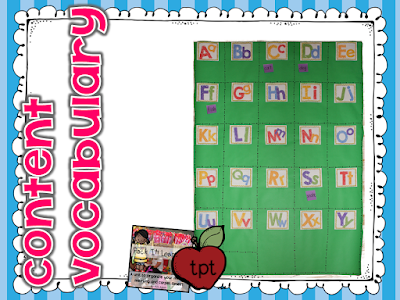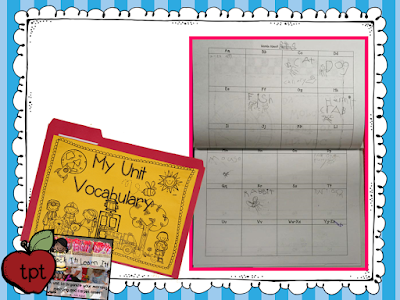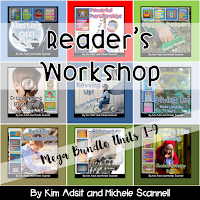During my recent webinar, Wacky, Wonderful World of Words, I was asked about my morning word work schedule. This blog post shows how I organize my daily word work using a carpet bag.
We've all been there. We want to fit it all in, but the day slips by and we realize that yet another day has passed and we didn't add those new words to the word wall. OR, we meant to work on the _ag word family last week, but another week has gone by and we still haven't made that list! I found myself in that boat! I realized I needed to come up with a plan. I needed to make a schedule and not just wait for those few minutes to fit it in. To get organized, here is what I did....I use a "carpet bag". Each of the children have their own bag. Each morning as part of getting ready for the day, the kids place their own personal carpet bag on their assigned square in our meeting area. What's in the bag? How do I use them?
Monday
Each day during our morning meeting, we take about 10-15 minutes to do a little word work. The first thing in the bag is the traveling word wall. Every MONDAY I add our new words. When I add the new words, the kids write the words on their traveling word wall. Want more information about this? I just did a blog post and explained everything in detail. You can read it
here.
Tuesday
On TUESDAY we look at our Unit Vocabulary. This is where we learn the vocabulary that is associated with our science and social studies standards. These are the words that are essential for children to comprehend what they are reading in non-fiction text. I just did a lengthy blog post about this, too. You can read it
here. Basically, I ask the kids to tell me words they know about the topic, for example "winter". As they tell me the words, I write them on post it notes and add them to the chart. The following weeks we add to the same chart until we start a new unit in science or social studies. At that time, I remove the post it notes, and we start a new chart.
As I add the words to the chart, the children add their words to their Unit Vocabulary Notebook.
Wednesday
Each WEDNESDAY we look at a word family. We start with the short vowel word families. I usually pick an "a" vowel word first. For example, we might make a list of _ag words, or _ad words, etc. We stay on a vowel for a few weeks or until I think the kids have grasped the concept of that vowel. We do this for all of the short vowels before moving on to the long vowel word families.
As the kids are brainstorming the words, I add them to the chart. In the beginning, the kids are mainly thinking rhyming, but that's okay. Rhyming is the phonemic "brother" to the phonics skill of word families. Some kids will be working phonetically while others are moving towards the phonics skill.
As I am adding the words to the chart, the kids are adding the words to their Word Family Journal. Don't get hung up on the handwriting. It's not about that. I have the children write the words as a way to encourage engagement. If the letters are not formed correctly, don't point it out. Make note, then at another time you can work on the actual letter formation!
Thursday
On THURSDAY we work in our Book of Lists. Each week we make a list of words that have a commonality. For example, if we are finishing up our shape unit during math, we might use this time to make a list of shape words. Or, if we just finished a study on characters, we might make a list of our favorite characters. This is a great way to once again visit vocabulary. We also use this time to practice stretching words. As we stretch the words, the kids write the letters. I fill in the letters they can't hear. At the beginning of the year, they are mainly providing the beginning and ending sounds. But, during the year, they begin to hear more of the sounds. No matter how many sounds they hear, the words are always spelled correctly with you filling in the sounds they do not hear.
Friday
On FRIDAY we visit our academic vocabulary words. We use Marzano's research to help us structure this time of the day. Each week we add our new words to our math or literacy vocabulary word wall. These are the words that we will visit that week during our instruction. On Friday, we pick one math word or one literacy word that we want to take to a deeper level of understanding. This is a word that we first introduced several weeks prior. The kids draw pictures and write definitions for the given word. Want more details on this? You can find it
here in a blog post!
Organization
Let's look at how we organize the bags!
At the beginning of the year, the bags are empty! The first year I made them, I filled the bags up during the summer. I was so excited! What a mess! The kids had everything dumped on the floor and mixed up with their neighbors. I took those bags back up and took everything out! Now, as we introduce each item, we add them to the bag. It takes several weeks to add everything. Here are a few of the other things we keep in the bag.
Supplies
Each child has a pencil bag filled with supplies. They have a pencil, marker, crayons, dry erase pen, dryer sheet (for erasing on the dry erase board), etc. If we are going to be using unifix cubes during math this week, I have each child put them in their carpet bags. This way, I don't have to pass them out each day! I can simply say, "get your cubes out!"
Sound Cards
Each child has a beginning sound card. We play lots of games with this card at the beginning of the year. As the kids become more familiar with the card, they can use it during writing to help them know how to write each letter. Later in the year we add the blends and diagraph card.
Nursery Rhyme Book
We also keep our nursery rhyme, or poetry journal, in our bags. We use these to practice fluency. Each day, we play our nursery rhyme of the week. As the song plays, the kids track along the print as they sing.
Yes-No Sticks
Each bag also has a "yes-no" response stick. These are great for answering questions. The children show their response using the stick.
Math Mats
Instead of having to pass out our math mats, I made a spiral bound book of the mats for each child. In the bottom right corner of each mat, I added an animal. This makes it very easy for kids to find the right page! I simply say, "turn to your number bond page. There is a bird in the corner." Now, just like that, they are ready to go. No wasted time passing anything out.
Storage
Each morning as the kids come in, they go to the baskets and get out their carpet bags. I have 3 baskets, one for each row. They put the bag on their carpet square, and it stays there ALL DAY! Now, yes it can look messy with those bags on the floor. I have to put on my blinders sometimes and just not look. But oh my goodness! What a change in engagement! What a change in wasted time! At the end of the day, the kids put their bags back in the correct basket to store it overnight! You can get these bags anywhere! I have picked them up at the Dollar Tree, Family Dollar, and Target. A bag usually last a few years before they need replacing.
All of the resources for the carpet bag are in this
unit.
EXCEPT for the Academic Vocabulary. It is in this
unit.
















































































